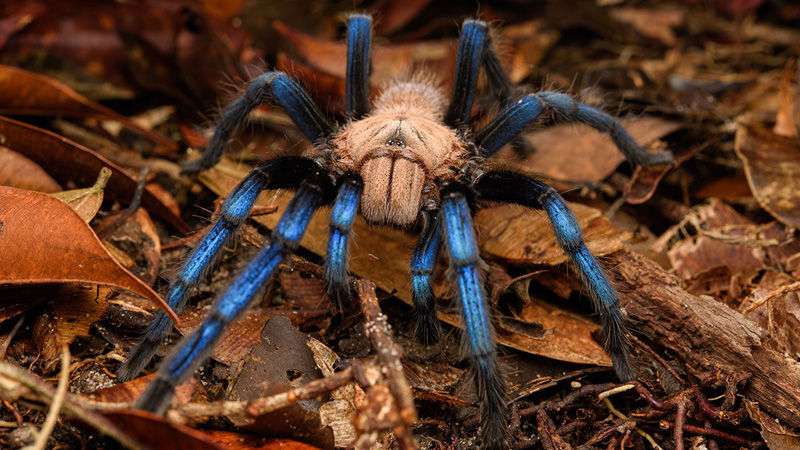10 FAQs About Cobalt Blue Tarantulas

As one of the most visually stunning species of tarantulas, cobalt blue tarantulas stand out for their beauty and mystique, inspiring curiosity and wonder among those who have the privilege of observing them.
Their defensive nature and aggressive temperament add to the mystery and intrigue surrounding cobalt blue tarantulas. Despite their captivating beauty, these tarantulas command respect and caution due to their venomous bite and quick defensive reactions when feeling threatened.
This combination of beauty and ferocity makes cobalt blue tarantulas a topic of fascination and study for tarantula enthusiasts and researchers alike.
In this article, we will explore ten frequently asked questions about cobalt blue tarantulas, providing in-depth answers for beginners and experienced keepers alike.
- 1. What is a Cobalt Blue Tarantula?
- 2. Is A Blue Tarantula rare?
- 3. What is the lifespan of a Cobalt Blue Tarantula?
- 4. How big do Cobalt Blue Tarantulas get?
- 5. Are Cobalt Blue Tarantulas aggressive?
- 6. Are Cobalt Blue Tarantulas good for beginners?
- 7. How Venomous Are Cobalt Blue Tarantulas?
- 8. How should I handle a Cobalt Blue Tarantula?
- 9. What Should be the Enclosure Setup for Cobalt Blue Tarantulas?
- 10. What do Cobalt Blue Tarantulas Eat?
1. What is a Cobalt Blue Tarantula?
Cobalt Blue Tarantulas, scientifically known as Cyriopagopus lividus (formerly Haplopelma lividum), are striking arachnids native to parts of Southeast Asia, primarily in Thailand, Myanmar, and Cambodia. In their natural environment, they dig intricate burrows that serve as their homes and hunting grounds. These burrows allow them to regulate their temperature, maintain humidity, and provide a safe haven from predators.
They are characterized by their vibrant blue coloration, which sets them apart from other tarantula species. In addition to their striking appearance, Cobalt Blue Tarantulas are known for their defensive behavior and specific care requirements.
2. Is A Blue Tarantula rare?
Yes!
Blue tarantulas are considered rare in nature, particularly those with a blue-violet hue resembling electrical sparks. Only about four percent of the 900 known tarantula species exhibit any blue coloring. This rarity adds to their allure and fascination among tarantula enthusiasts and researchers alike.
3. What is the Lifespan of a Cobalt Blue Tarantula?
Cobalt Blue Tarantulas have a relatively long lifespan compared to other tarantula species. In captivity, female cobalt blue tarantulas can live up to 25 years, while males have a shorter lifespan of about 10 years. In the wild, these tarantulas can live up to 30 years for females and 20 years for males.
It's important to note that these figures are approximate and can vary depending on several factors. The lifespan of cobalt blue tarantulas, like all tarantulas, can be influenced by environmental conditions, such as temperature, humidity, and the overall quality of care provided by their keepers.
4. How big do Cobalt Blue Tarantulas get?
Adult cobalt blue tarantulas typically have a leg span of around 5 to 6 inches (12 to 15 centimeters), making them medium-sized tarantulas. Their slender bodies and long legs contribute to their elegant and striking appearance.
When cobalt blue tarantulas are in their juvenile stage, they are typically smaller in size. However, with proper care, feeding, and the right environmental conditions, they can grow rapidly. As they molt and shed their exoskeleton, they go through several stages of growth called instars, gradually increasing in size and reaching their adult form.
5. Are Cobalt Blue Tarantulas aggressive?
Yes!
Cobalt Blue Tarantulas are known for their defensive and sometimes aggressive behavior. When threatened or provoked, they may adopt defensive postures, such as rearing up on their hind legs or flicking urticating hairs. While they are not typically aggressive toward humans, they may deliver a potent bite if they feel threatened.
It's important to note that individual temperament can vary among cobalt blue tarantulas just as it can with other tarantula species. Some individuals may be more defensive or prone to aggression than others. Therefore, it is crucial to handle them with caution and respect their boundaries.
6. Are Cobalt Blue Tarantulas good for beginners?
Due to their temperamental nature and defensive behavior, cobalt blue tarantulas are generally not recommended for beginners. Their aggressive tendencies and venomous bite pose challenges for inexperienced handlers. It is crucial for beginners to gain experience and knowledge with more docile tarantula species before considering the care of cobalt blue tarantulas.
7. How Venomous Are Cobalt Blue Tarantulas?
The venom of cobalt blue tarantulas is potent and can result in discomfort and pain if bitten. While the venom is not typically life-threatening to humans, it can lead to allergic reactions, such as swelling, redness, and itching. However, severe reactions are uncommon, and most bites result in localized symptoms that diminish over time.
It is important to note that tarantula bites should be taken seriously, and anyone bitten by a cobalt blue tarantula or any other tarantula should seek medical attention if experiencing severe symptoms or if they are uncertain about their reaction to the bite. While rare, some individuals may have stronger allergic reactions or be more sensitive to the venom, which can require medical intervention.
8. How should I handle a Cobalt Blue Tarantula?
Handling a Cobalt Blue Tarantula should indeed be approached with caution due to their defensive nature. It is crucial to avoid handling them unless absolutely necessary. If handling becomes necessary for maintenance or rehousing, it is recommended to use gentle techniques and appropriate tools, such as a catching cup or soft paintbrush, to minimize the risk of injury to both the tarantula and the handler. Wearing protective gloves can also provide an extra layer of safety during such instances. Remember to wash your hands thoroughly before and after any handling to prevent any potential transfer of harmful substances.
9. What Should be the Enclosure Setup for Cobalt Blue Tarantulas?
Cobalt blue tarantulas require a suitable enclosure that replicates their natural habitat. A spacious terrarium with a secure lid is essential to prevent escapes. The enclosure should provide hiding spots, such as artificial caves or bark, and climbing structures like logs or branches. Maintain consistent temperatures between 26 to 32°C and a humidity level of around 70-80% to promote their overall well-being.
10. What do Cobalt Blue Tarantulas Eat?
In the wild, Cobalt Blue Tarantulas primarily feed on a diet of insects, such as crickets, roaches, and mealworms. In captivity, they can be fed a variety of live prey items, supplemented with occasional treats like pinkie mice or superworms. It's essential to offer appropriately sized prey items to prevent overfeeding and obesity.
Generally, feeding adult Cobalt Blue Tarantulas once every one to two weeks is sufficient. Remember to always provide a clean water source for your Cobalt Blue Tarantula, as hydration is crucial for their overall health and well-being.
Conclusion
Breeding Cobalt Blue Tarantulas at home can be a complex and challenging process. It requires specific knowledge and expertise in tarantula breeding to be successful. While it is technically possible to breed Cobalt Blue Tarantulas in captivity, it is not recommended for inexperienced tarantula keepers.
If you are interested in breeding Cobalt Blue Tarantulas, it is advisable to gain experience and knowledge by breeding other species first. This will help you understand the general principles of tarantula breeding and provide you with the necessary skills and insights.
You May Also Like
 Other Pets50 Popular Names for Tarantulas (with Meaing)
Other Pets50 Popular Names for Tarantulas (with Meaing) Other PetsAre Cobalt Blue Tarantulas Suitable for Beginners?
Other PetsAre Cobalt Blue Tarantulas Suitable for Beginners? Other Pets6 Best Tarantula Species for Beginners
Other Pets6 Best Tarantula Species for Beginners Other PetsWhat Happens if a Cobalt Blue Tarantula Bites You?
Other PetsWhat Happens if a Cobalt Blue Tarantula Bites You? Other PetsWhat Happens if a Pink Toe Tarantula Bites You?
Other PetsWhat Happens if a Pink Toe Tarantula Bites You? Other PetsWhat Happens if a Rose Hair Tarantula Bites You?
Other PetsWhat Happens if a Rose Hair Tarantula Bites You?